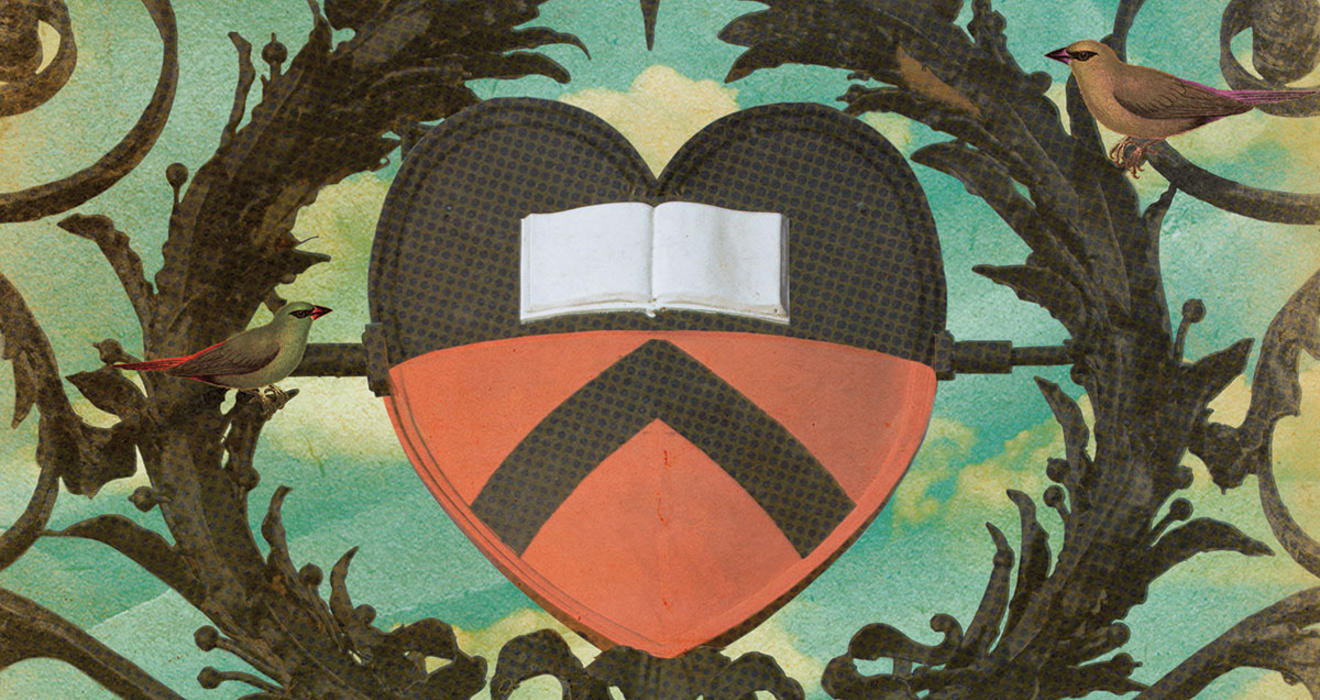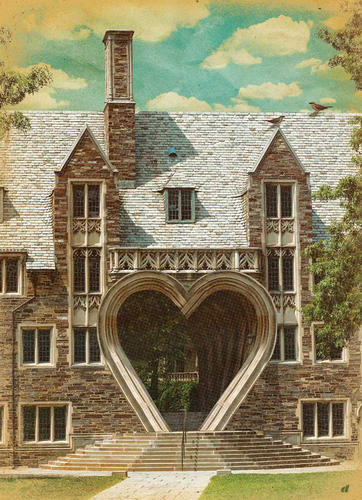
Last February, large red posters titled “How To Win At A First Date” appeared around campus, and leaflets were placed on tables in the dining halls. All offered tips for how to have a great first date. Tip one: Be spontaneous. Tip six: It’s OK to seem interested. Tip seven: Have fun, because it’s just a date. And at the bottom, a hashtag declared: #BringDatingBack.
The posters and leaflets were part of a campaign run each Valentine’s Day for the last several years by the Love and Fidelity Network, a national program based in Princeton that promotes love and “sexual integrity” at universities. The network was founded by Cassandra Hough ’07, who also co-founded Princeton’s Anscombe Society as a sophomore in response to her frustrations with the campus “hookup” culture. Similar poster campaigns took place at 30 other schools, including several Ivies.
“Many of us ... were frustrated that the intellectual and social life was dominated by this casual, ‘anything goes’ mentality toward sex and relationships,” says Hough. There was no campus conversation that took sex and relationships seriously, she says, “or that even talked about dating, and how dating could be a fun, interesting way to get to know people.”
The #BringDatingBack hashtag prompts the question: Is dating dead at Princeton? Is courtship — with all the attention, time, and commitment it requires — too much for students to squeeze into already-packed schedules?
With all the Princeton marriage photos filling up the back pages of Class Notes, PAW readers might be forgiven for thinking that everyone finds love at Old Nassau. The Alumni Records office knows of 4,089 couples in which both partners are Princeton alumni.
Katherine Hawkins Hwang ’15 is half of one of those couples.
“I came in expecting to marry,” she says. Hwang graduated from a small Christian school in Montana, and a fifth of her graduating class of 30 married out of high school. Arriving at Princeton, she thought, “If things ran the normal course ... I would find someone” on campus.
And things did “run the normal course.” Katherine met Daniel Hwang ’15 during her freshman year at the Princeton Evangelical Fellowship, where they were both members. They started dating in their sophomore year, got engaged over winter break of their senior year and, after juggling the planning of their wedding and writing their theses, they married shortly after their graduation. They now live together in a cozy apartment in town and work as ministry interns at the Fellowship.
Daniel wasn’t the first in his family to find love at Princeton. His father, William Hwang ’84, met his wife, Esther Ya-Ya Hwang ’83, on campus. Daniel’s brother, Jonathan Hwang ’09, also married a fellow student, Melissa Plapp ’09. Coincidentally, Katherine’s senior-year roommate, Eunhae Park ’15, also met her husband Jojo Cheng ’15 at Princeton. They got married the day after their graduation.
Sarah Porter ’16 — like many other students — has had a different campus experience. She also arrived at Princeton expecting that a long-term relationship — perhaps even marriage — would be inevitable. But she has not found love, and “there haven’t been very many sub-archway kisses,” she says. She is disillusioned with the almost non-existent dating culture at Princeton, where busy students turn to hooking up on the Street to sidestep their aversions to commitment and potential rejection.
“People used to date. Now people are so afraid of commitment or having ‘the talk,’” Porter says. “It’s almost cliché, the ‘so what are we?’ conversation.”
For decades, dating at Princeton was circumscribed by the women’s visiting rules known as parietals. Women arrived by the busload for campus parties, but the rules put a damper on what could happen afterward. “You could entertain a Lady (it would most certainly be a Lady with a capital ‘L,’ of course) any way you wished ... until 6 p.m.,” PAW Online columnist and Princetoniana expert Gregg Lange ’70 has written. “The rule was memorialized as Sex after Six.” By the end of the 1960s, with the beginnings of coeducation, parietals were virtually dead, a victim of lax enforcement. Lange recalled how “one memorable 5:25 a.m. fire in Patton Hall in the ’60s spilled half as many forbidden women onto the lawn as students (the landlord was not pleased).”
In 1971, two years after coeducation began, the male-female ratio was 19 to 1 — a rough dating environment by any measure. Openly gay students in those days were rare. Today, the male-female ratio is about 50-50, and relationships all along the gender spectrum are far more open. Some students suggest that social bonding encouraged in the residential-college system has made it easier and more convenient to develop romantic relationships even in the first months at Princeton. Leila Clark ’18 says that she has seen numerous “zee-group couples,” referring to students from the same residential-college advising groups. Others take more time: “I see a lot of people in relationships, especially by senior year,” says Daniela Cosio ’16.
“People used to date. Now people are so afraid of commitment or having ‘the talk.’ It’s almost cliché, the ‘so what are we?’ conversation.”
— Sarah Porter ’16
Still, others place less emphasis on finding love. The media have covered the demise of dating in college, largely replaced by a hookup culture centered on casual sexual relationships. A 2013 study by University of Portland sociologist Martin Monto and co-author Anna Carey found that while contemporary college students did not report having more frequent sex or more sexual partners than undergraduates in the 1988–1996 period, they were more likely to have casual partners and less likely to be in a long-term relationship.
About 2,500 Princeton students use the social-networking app Friendsy (among other apps) to meet people, specifying whether they want to find a friend, date, or hookup. According to Friendsy, which was founded by Michael Pinsky ’15, almost half of the clicks have been for friends. About a third are for hookups, and 17 percent for dates.
Everyone is “so truly busy,” Porter says. “Here, you have to very purposely set aside time [for dating]. You can easily spend 100 percent of your time on schoolwork. It’s like what people say: You can pick two of three things: school, social, sleep.” Partly because of this perpetual time crunch, the various aspects of students’ lives are packed together, she continues. “In the same spaces, I hook up with people, I do school work, and at the same time balance academics and athletics –– all within such a small sphere and in one day,” she says. The pressure makes it difficult “to relax and go with the flow when meeting someone.”
Students “don’t dial back” when they party, Porter says — the intensity carries over from the classroom to the Street. “The idea of ‘fun’ is Saturday night at 1 a.m. and all things associated with that: the grimy dance floor, and definitely alcohol,” she says. Has the national spotlight on sexual assault changed the environment? Some undergraduates interviewed suggest that while the hookup scene has not grown smaller, students are more likely to seek consent.
“Everything is geared toward work. Everyone’s busy, therefore no one commits,” says a junior from France. He declined to start a relationship during his first two years on campus because of his schedule, but has a girlfriend now. Even so, the two students put their work first and don’t impose “unrealistic expectations” on each other, he says.
Christy Wampole, an assistant professor of French and Italian at Princeton, writes about contemporary life, irony, and our distracted culture in a new book, The Other Serious: Essays for the New American Generation. She says today’s dating culture is part of a general tendency to want to control and organize every aspect of our lives: “One’s love life is something to be managed” like finances and career choices, she says in an email. “Online, you can customize your preferences and opt for the most ‘efficient’ companion. ... As much as possible, chance is eliminated from the equation.” That’s a change from traditional relationships, which — as anyone who has been in one knows — are nothing if not messy.
Graduate students, a bit further along in life, seem more willing to start long-term relationships and date fellow master’s-degree and Ph.D. students. Macs Smith, a fifth-year doctoral student, says that his department, French and Italian, has had three marriages and an engagement in the last calendar year, two of them between students who met on campus. Yet grad students lament that it’s not easy to meet people at Princeton: A friend of Smith once described the University as “a place where sexual tension goes to die.”
The Graduate School tries to spice up student social life through regular activities and excursions, including speed-dating events held once or twice a year for heterosexual and LGBT students. But Natalia Cordova, a fifth-year neuroscience Ph.D. student, observes that planners often must solicit women to sign up and limit participation by men. “You get that email and you’re like, wow, I don’t want to go to this,” she says, suggesting that this makes the men appear a bit ... desperate. “It sounds like the odds are good, but the goods are odd,” she said. (To be fair, men still make up 61 percent of all graduate students — and 74 percent of grad students in engineering.)
Are students satisfied with the campus social scene today? That’s not clear. In her book The End of Men, Hanna Rosin argues that hookups can work well for college women, who often see them as a way to have a satisfying sex life while focusing on academic and professional goals. But New York University sociologist Paula England, who conducted an online survey of 24,000 students at 21 colleges, found different results.
Both men and women wished there were more opportunities at school to find someone to have a relationship with, and said they would like to be in an exclusive relationship if they could find the right person. Only 16 percent of surveyed women wished their schools offered more opportunities for hooking up, compared to 48 percent of the men.
Pamela Soffer ’15 suggests that women are more likely to be disappointed in hookups than men are. Soffer wrote her senior thesis in psychology on online dating, surveying 200 Princeton students who had been shown sexualized or non-sexualized photographs. The men responded to the sexualized photos by increasing the value of short-term qualities and lessening the value of long-term relationships. Extending her thesis to Princeton’s social scene, she hypothesizes that Prospect Street functions like the sexualized photos, and men in that context would exhibit a greater desire than women for casual relationships. No one is completely satisfied. “There’s a conflict of expectations,” she says. “Most of the disappointment, most of the controversy with hookups ... comes from that.”
So the Love and Fidelity Network’s Valentine’s Day campaign is likely to continue, its members hoping to show students a different path — and to teach the basics of courtship. Most students he knows do indeed want a real relationship, says Thomas Clark ’18, the vice president of the Anscombe Society — but “we don’t know what that is, what that entails.”
For some, being in love means feeling affection or passion, “almost like a giddiness,” Clark says. For others, love is not just a passive feeling, but is rather “a choice, a decision.” That makes love hard to talk about.
“Everyone is looking for love in some way,” he says, “but differences in vocabulary mean that we end up completely missing each other.”
Mary Hui ’17 is a PAW contributor and Press Club member.







No responses yet